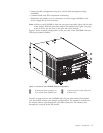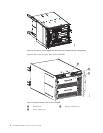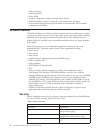
High availability
The following features contribute to the SAN384B's high-availability design:
v Redundant, hot-swappable blades and FRUs
v Enhanced data integrity on all data paths
v Fabric Shortest Path First (FSPF) rerouting around failed links
v Integration with Simple Network Management Protocol (SNMP) managers
v Automatic control processor failover
v Nondisruptive "hot" software code loads and activation
v Easy configuration, save, and restore
v Hot-swappable World Wide Name (WWN) cards
The high-availability software architecture of the SAN384B provides a common
framework for all applications that reside on the system, allowing global and local
status to be maintained through any component failure. High-availability elements
consist of the High Availability Manager, the heartbeat, the fault/health
framework, the replicated database, initialization, and software upgrade.
The High Availability Manager controls access to the standby control processor,
facilitates software upgrades, prevents extraneous switchover activity, closes and
flushes streams, provides flow control and message buffering, and supports a
centralized active and standby state.
Reliability
The SAN384B uses the following error detection and correction mechanisms to
ensure reliability of data:
v Error Detection and Fault Isolation (EDFI) mechanism, which checks for encoder
errors and fault isolation, such as cyclic redundancy checking (CRC), parity
checking, checksum, and illegal address checking.
v Power-on self test (POST)
v Dual control processors that enable hot, nondisruptive fast firmware upgrades
v Each control processor contains one serial port and two Ethernet ports, for
management and for service. Offline control processor diagnostics and remote
diagnostics simplify troubleshooting. The standby control processor monitors
diagnostics to ensure it is operational, should a failover be necessary
v Bus monitoring and control of blades and other field-replaceable units (FRUs).
Serviceability
The SAN384B provides the following features to enhance and ensure serviceability:
v Modular design with hot-swappable components
v Flash memory that stores two firmware images per control processor
v USB port on control processor blades for all tasks that formerly required an
FTP/SCP server, including software and firmware upgrades
v Nonvolatile random-access memory (NVRAM), containing the OEM serial
number, IBM serial number, revision information, and part number information
v Background health-check daemon
v Memory scrubber, self test, and bus ping to determine if a bus is not functioning
v RASlog messages
Chapter 1. Introduction 7
|
|
|
|
|


















